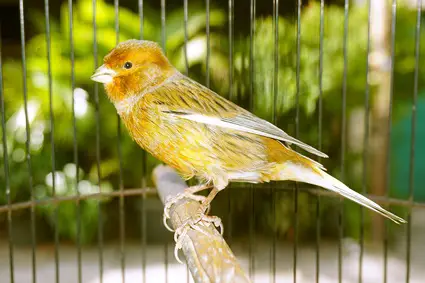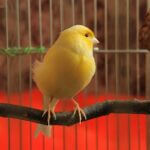A healthy canary will have bright, open, and black eyes with no signs of swelling or discoloration.
Ocular care is an essential part of canary husbandry. All birds can experience eye injuries, infections, and diseases, but canaries are among the likeliest to experience these concerns.
Canaries can scratch or injure their eyes while preening, exercising, or playing. They’re also more prone to cataracts than other birds and risk developing conjunctivitis.
Many infectious diseases can impact a canary’s eyes, including toxoplasmosis, uveitis, Marek’s disease, and avian pox. These concerns can lead to blindness or be fatal if undiagnosed and untreated.
Common Canary Eye Issues
Here are the most common eye issues in canaries:
1/ Impact Injuries
Trauma from cage mates commonly results in injuries to canaries’ eyes. When canaries live in close proximity, which isn’t recommended, it’s common for them to enter territorial disputes.
During fights, canaries (especially males) may peck each other, injuring each other’s eyes.
Canaries are inquisitive birds that may be injured by household items when getting out-of-cage time. For example, active ceiling fans can cause injuries to pet birds.
If a canary has overgrown claws and parasites, it could hurt its eye when relieving an itch.
2/ Conjunctivitis
Conjunctivitis in canaries (also known as ‘red eye’) is an inflammation of the conjunctiva, the thin membrane that covers the inner eyelids and the white area of the eye.
If a canary has conjunctivitis, its eyelids will likely be swollen shut, crusty, and discolored. Other common symptoms include sensitivity to light and cloudy or discolored eyes.
The most common causes of ‘red eye’ include bacterial infections, viral infections, allergies, eye irritation, foreign bodies in the eye, nutritional deficiencies (vitamin A), and trauma.
The impacted eye or eyes must be washed with a saline wash solution. Also, the canary may require antibacterial eye drops and dietary changes.
3/ Cataracts
Cataracts lead to reduced vision and can cause blindness if left uncorrected. The symptoms include opacity of the lens (cloudiness or haziness of the eye) and reduced vision.
A cataract is easy to detect because there will be an expanding whiteness in the canary’s eye. Over time, this milky whiteness becomes more prominent, and its vision will be restricted.
Canaries can develop cataracts in one or both eyes.
The causes of cataracts in canaries include the following:
- Genetics: According to Avian Pathology, canaries are most likely to inherit cataracts from a parent.
- Nutrition: Diets lacking vitamins A, C, and E and minerals like zinc, copper, and selenium.
- Medications: Treatments for allergies, like corticosteroids (a hormone), can lead to cataracts due to decreased vitamin A production.
- Toxins: Heavy metals (lead and mercury) and some pesticides can cause eye inflammation.
- Living environment: Bad lighting can result in a decrease in vitamin A production. Also, a particularly dusty living environment can lead to inflammation of the eye(s).
- Virus: Viral conditions, like poxvirus and adenovirus, cause eye cloudiness and cataracts.
- Bacterial infection: Bacteria, like streptococcus, pseudomonas, and staphylococcus, can cause the eye to become inflamed and hazy.
Treatment involves the surgical removal of the cataract and lens replacement. Also, medication may be required to minimize the cataract’s opacity.
4/ Keratitis
Keratitis results in an inflamed cornea. This inflammation may be due to a bacterial infection, an external virus, trauma to the eye, or a trapped foreign object lodged in the eye.
The first warning sign of avian keratitis is a bloodshot redness around the cornea.
This will be subtle at first before growing increasingly pronounced. If you notice a spreading whiteness over the cornea, keratitis is advancing and could be causing cataracts.
Antibiotic eyedrops and anti-inflammatories will always be the first treatment for keratitis, along with regular washing of the eye and surrounding area with a saline solution.
Surgery may be needed to prevent the eye from developing a cataract.

5/ Corneal Ulcers
A corneal ulcer will initially display symptoms similar to the cornea’s inflammation, but the eye will become increasingly opaque, and the color will be closer to blue than white.
As with keratitis, eyedrops will be the initial treatment, but this is less likely to be effective when managing a corneal ulcer.
A canary may need light therapy. This drains pressure from the associated lymph nodes, reduces pain, and promotes the healing of the ulcer by stimulating endorphin release.
6/ Periorbital Abscess
Periorbital cellulitis is a bacterial infection of the tissues that surround the eye, primarily the eyelid. Bacteria like Staphylococcus aureus and Streptococcus pyogenes cause this condition.
The common symptoms of periorbital cellulitis are redness, swelling, and discharge from around the eye.
Canaries with periorbital cellulitis are given vet-prescribed antibiotics to clear up the infection. The antibiotic selected will be based on the bacteria that led to the infection.
Commonly prescribed antibiotics for periorbital cellulitis are amoxicillin, ciprofloxacin, and erythromycin.
The veterinarian will sometimes administer an anti-inflammatory medication like prednisone to deal with the inflammation and swelling.
Surgery is seldom necessary to treat periorbital cellulitis in canaries. However, it may be recommended if the infection fails to respond to the antibiotics or further complications arise.
7/ Toxoplasmosis
Toxoplasmosis arises due to the presence of the toxoplasma gondii parasite. The symptoms include:
- Breathing problems
- Depression
- Appetite loss
- Discharge from the eye
The Journal of the American Veterinary Medical Association warns how toxoplasmosis can be connected to canary eye concerns, including blindness and eye ulcers.
Toxoplasma gondii is found in avian feces, so you must regularly clean the canary’s cage. The parasite can also be found in cat and dog feces and urine, so remain mindful of other pets.
Toxoplasmosis can be treated with antibiotics, antiparasitics, antifungals, and antivirals.
8/ Uveitis
Uveitis leads to inflammation of a canary’s uvea (middle layer of the eye). The symptoms include:
- Redness or cloudiness
- Swelling
- Eye pain
- Teariness
- Blurry vision
- Photophobia (sensitivity to light)
- Squinting
- Increased blinking
The most common causes of uveitis include fungal infection, eye injuries, bacterial infection, and immune-mediated disease (the immune system mistakenly attacks its tissues).
Usually, uveitis is treated with eyedrops that contain NSAIDs to reduce inflammation. Left untreated, uveitis can lead to cataracts and even cost a canary the use of an eye.
9/ Mycoplasma Infection
Mycoplasma Infection is a respiratory disease caused by Mycoplasma gallisepticum (a type of bacteria). Scientific Reports explains how mycoplasma is common in wild birds because it’s highly contagious.
Antibiotics (usually like oxytetracycline or doxycycline) will be prescribed for a canary with mycoplasma, as it’s directly linked to conjunctivitis.
Mycoplasma has similar symptoms to ‘conjunctivitis ‘red eye,’ including swelling around the eyes.
Usually, antibiotics will take the form of eye drops. Treatment usually lasts for several weeks, and reoccurrences are common.
In rare cases, a canary may need intravenous treatment, where antibiotics enter the bloodstream via an intravenous line (inserting a narrow and flexible tube into a vein).
10/ Avian Pox
Avian pox (also known as Avipoxvirus) is a highly contagious viral infection. Avian Diseases stated that avian pox could cost a bird its life within 3 weeks if left untreated.
Avian pox manifests as warts and growths on the skin, especially on the head. The eyes will be most impacted, so be wary of bright pink, yellow, red, or gray growths.
There’s no treatment for avian pox, but a vaccine to reduce the chances of transmission is available.
11/ Marek’s Disease
Marek’s disease is a form of T-cell lymphoma and is most commonly associated with chickens and turkeys. It can also impact companion birds in the form of ocular lymphomatosis.
If a canary has Marek’s disease, it’ll have unequal pupil sizes, and you’ll likely see the iris in one or both eyes fading to gray. Eventually, it can result in sight loss.
There’s no cure for Marek’s disease, so if a canary develops this condition, it may need to be euthanized. Thankfully, there is a vaccine available that can protect canaries.
Can Canaries Go Blind?
Blindness can ensue if a concern, such as conjunctivitis, is left unresolved. An untreated eye infection can cause secondary infections, further harming the eyes and eventually resulting in sight loss.
A vitamin A deficiency can lead to blindness. If a canary isn’t getting sufficient vitamin A in its diet, it’s more likely to develop cataracts, night blindness, and blindness.
Inherited conditions like cataracts, glaucoma, and progressive retinal atrophy can lead to vision loss. These medical conditions will result in visual deterioration until a canary’s completely blind.








